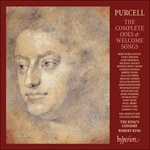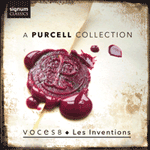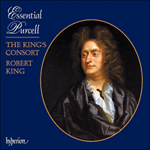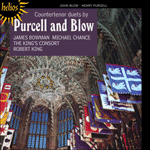
Welcome to Hyperion Records, an independent British classical label devoted to presenting high-quality recordings of music of all styles and from all periods from the twelfth century to the twenty-first.
Hyperion offers both CDs, and downloads in a number of formats. The site is also available in several languages.
Please use the dropdown buttons to set your preferred options, or use the checkbox to accept the defaults.

The overture (re-used the following year in The Indian Queen) begins in stately fashion, its opening ten bars full of glorious harmony, and the lively canzona which follows is full of rhythmic ingenuity amongst its three contrasting motifs. But it is in the wistful adagio section that Purcell is at his finest: the sighing motifs and poignant harmonies are full of pathos, and the use of sustained notes, which cut through the middle and bass of the texture, is quite extraordinary. Rather than the expected repeat of the canzona, we are immediately led into the opening chorus, and the first of several repetitions of the main theme in various harmonizations and arrangements—a technique taken straight from the theatre. With the tune taken first by a countertenor, Purcell cleverly solves the problem of re-scoring for the chorus (where the tune would have either been too low or far too high for the sopranos) by providing them with a descant and retaining the tune in the altos, doubled by the trumpet and oboe. In the famous duet ‘Sound the trumpet’ Purcell resisted the temptation to use the actual named instruments, choosing instead an insistently lively two-bar modulating ground bass over which two countertenors demonstrate their virtuosity and giving the royal continuo players splendidly characterful lines. There would have been wry smiles in the orchestra at ‘You make the list’ning shores resound’, for two of the instrumentalists sitting in the band would have been the famous trumpeters Matthias and William Shore.
The centre-piece of the Ode is an ecstatic evocation of music, ‘Strike the viol’. With its mentions of viol, lute, harp and flute (recorder) Purcell was, as he always was by references to music, at his most inspired. The technique he uses was one that he had perfected in numerous previous Odes, combining a ground bass with a line for solo countertenor and then turning the vocal section into an instrumental ritornello. Here he uses a modulating two-bar ground bass, with two recorders adding their gentle accompaniment, over which the soloist weaves his entrancing melody. The best is still to come, for Purcell develops an orchestral ritornello that is one of his finest, alternating and combining the pair of recorders with the strings to create a ravishing movement.
‘The day that such a blessing gave’ is first given to a solo bass, with Purcell’s harmonic skill solving all the problems attendant with putting the melody in the bass line. At the mid-point he transforms the solo into a full chorus, still retaining the melody at the bottom of the texture and once again giving the trebles of the choir a descant to sing. ‘Bid the Virtues’ is quite unique, even amongst the many remarkable movements contained in the Odes. A solo soprano and oboe intertwine in glorious harmonic and melodic writing, at moments florid, at others most touching, all showing Purcell’s ability to set words with extraordinary eloquence. Next comes a rumbustious aria for solo bass, ‘These are the sacred charms’, set over a jaunty ground bass. The final movement ‘See Nature, rejoicing’ is first sung as a duet by the soprano and bass, with contrast between repetitions of the rondeau given by two minor episodes, before the whole choir and orchestra take up Purcell’s strain.
The only complete source material for Come ye sons of Art is a copy by Robert Pindar, dating from 1765, and contains several dubious pieces of scoring which this performance corrects. Purcell scored his overture for one trumpet and one oboe, though in subsequent movements he uses a pair of each. Some modern editors have added an editorial part for a second trumpet (often ignoring the fact that Purcell’s trumpets could play very few notes in their lower registers) and doubled oboes on these lines. Purcell’s intentions appear to have been different, and in the overture we return to his scoring which gave Shore’s remarkable trumpet playing the top line, and the oboe, in its richest register, the second part. Pindar’s manuscript also contains a timpani part in the final chorus, wildly ornamented and out of keeping with other timpani parts of the era. For the opening chorus there is little possibility that the instruments could have been used, for the music moves too far away from the tonic and dominant. But in the last chorus ‘See Nature, rejoicing’ the music is of a different character, tonally more stable, and it is hard not to imagine a timpani part. After all the repetitions of the music in the duet that precedes the chorus, a timpanist could easily have improvised his line.
from notes by Robert King © 2010
L’ouverture (réutilisée l’année suivante dans The Indian Queen) commence solennellement par dix mesures aux harmonies splendides tandis que les trois motifs contrastifs de l’enjouée canzone suivante regorge d’ingéniosité rythmique. Mais c’est dans la mélancolique section adagio que Purcell est à son meilleur: les motifs soupirants et les harmonies poignantes débordent de pathos, et l’usage de notes tenues, transperçant le centre et la basse de la texture, est extraordinaire. Au lieu de l’attendue reprise de la canzone, nous enchaînons directement sur le chœur d’entrée et la première d’une série de répétitions du thème principal dans divers arrangements et harmonisations—une technique tout droit venue du théâtre. En confiant l’air d’abord à un contre-ténor, Purcell résout intelligemment le problème de la réécriture pour le chœur (l’air y aurait été soit trop grave, soit trop aigu pour les sopranos) en octroyant à ce dernier un déchant et en conservant la mélodie aux altos, doublés par la trompette et le hautbois. Dans le célèbre duo «Sound the trumpet», résistant à la tentation d’utiliser les instruments énumérés dans le texte, il opta pour un ground bass modulant de deux mesures—constamment enjoué, par-dessus lequel deux contre-ténors font étalage de leur virtuosité—et donna aux continuistes royaux des lignes superbement expressives. À «You make the list’ning shores resound», certains, dans l’orchestre, durent arborer un sourire ironique car deux des instrumentistes étaient les célèbres trompettistes Matthias et William Shore.
Le cœur de l’Ode est une extatique évocation de la musique, «Strike the Viol». Avec un tel texte mentionnant la viole, le luth, la harpe et la flûte (sous-entendu à bec), Purcell se montra des plus inspirés, comme toujours quand il était question de musique. Utilisant une technique perfectionnée dans nombre de ses Odes antérieures, il combina un ground bass avec une ligne pour contre-ténor puis transforma la section vocale en ritornello instrumental. Ici, il recourt à un ground bass modulant de deux mesures, avec deux flûtes à bec ajoutant leur doux accompagnement, le soliste tissant sa mélodie enchanteresse par-dessus. Mais le meilleur reste à venir car Purcell développe l’un de ses plus beaux ritornelli orchestraux, alternant et combinant les flûtes à bec et les cordes pour créer un mouvement ravissant.
«The day that such a blessing gave» est confié d’abord à une basse solo, la maîtrise harmonique de Purcell résolvant tous les problèmes inhérents au fait de placer ainsi la mélodie à la ligne de basse. À mi-parcours, il transforme le solo en chœur entier, tout en conservant la mélodie au bas de la texture et en confiant une nouvelle fois un déchant aux sopranos du chœur. «Bid the Virtues» est tout à fait unique, même parmi les nombreux mouvements remarquables des Odes. Une soprano et un hautbois s’entremêlent en une resplendissante écriture harmonico-mélodique, tantôt fleurie, tantôt émouvante, qui ne laisse de démontrer l’aptitude purcellienne aux mises en musique extraordinairement éloquentes. Survient ensuite une exubérante aria pour basse solo, «These are the sacred charms», sur un ground bass enlevé. Le dernier mouvement, «See Nature, rejoicing» est d’abord chanté par un duo soprano/basse, avec des contrastes entre les répétitions du rondeau donné par deux épisodes en mineur, avant que tout le chœur et l’orchestre ne reprennent le chant purcellien.
Le seul document complet concernant Come ye sons of Art est une copie de Robert Pindar datant de 1765 et recelant plusieurs morceaux douteux, corrigés ici. Purcell conçut son ouverture pour une trompette et un hautbois même si, dans les mouvements suivants, il doubla ces instruments. Certains éditeurs ont ajouté une partie pour une seconde trompette (ignorant souvent que les trompettes purcelliens pouvaient jouer seulement très peu de notes dans leur registre inférieur) et doublé les hautbois sur ces lignes. Purcell l’entendait, semble-t-il, différemment et nous retrouvons, dans l’ouverture, l’instrumentation qui le voit confier la ligne supérieure à la remarquable trompette de Shore et la seconde partie au hautbois, dans son registre le plus aigu. Dans le manuscrit de Pindar, le chœur final a aussi une partie de timbales largement ornée et se départant des autres parties de timbales de l’époque. Pour le chœur inaugural, il n’est guère possible que ces instruments aient été utilisés, la musique s’éloignant trop de la tonique et de la dominante. Dans the dernier chœur «See Nature, rejoicing»), en revanche, la musique, tonalement plus stable, est d’une tout autre trempe, et il est difficile de l’imaginer sans partie de timbales. Après toutes les répétitions de la musique survenues dans le duo qui précède le chœur, un timbalier aurait pu sans peine improviser sa ligne.
extrait des notes rédigées par Robert King © 2010
Français: Hypérion
Die Ouvertüre (die er im folgenden Jahr in The Indian Queen wiederverwendete) beginnt in stattlicher Art und Weise; die ersten zehn Takte zeichnen sich durch prachtvolle Harmonik aus, und die anschließende lebhafte Canzona weist viele rhythmische Einfälle nebst drei kontrastierenden Motiven auf. In dem melancholischen Adagio-Teil zeigt sich Purcell jedoch von seiner besten Seite. Die Seufzermotive und ergreifenden Harmonien sind voller Pathos, und der Einsatz von ausgehaltenen Noten, die sich durch die mittleren und tiefen Stimmen ziehen, ist außergewöhnlich. Anstelle der erwarteten Wiederholung der Canzona geht es direkt mit dem Anfangschor weiter, sowie der ersten von mehreren Wiederholungen des Hauptthemas in unterschiedlichen harmonischen Ausprägungen und Arrangements—eine direkt vom Theater übernommene Technik. Indem die Melodie zuerst von einem Countertenor gesungen wird, löst Purcell geschickt das Problem der Umsetzung für den Chor (wo die Melodie entweder zu tief oder für die Sopranstimmen viel zu hoch gewesen wäre). Außerdem fügt er eine Diskantstimme hinzu und lässt die Melodie den Altstimmen, die von der Trompete und Oboe verstärkt werden. Bei dem berühmten Duett „Sound the trumpet“ widerstand Purcell der Versuchung, die im Text genannten Instrumente zu verwenden, und entschied sich stattdessen für einen lebhaften zweitaktigen modulierenden Basso ostinato für die königlichen Continuo-Spieler, worüber zwei Countertenöre ihre Virtuosität demonstrieren. Bei „You make the list’ning shores resound“ („Du lässt lauschende Ufer widerhallen“) wurde im Orchester sicherlich geschmunzelt—man kann mit einiger Sicherheit davon ausgehen, dass zwei der Instrumentalisten des Ensembles die berühmten Trompeter Matthias und William Shore waren.
Das Herzstück der Ode, „Strike the viol“, ist eine ekstatische Darstellung der Musik. Es werden darin die Gambe, Laute, Harfe und Flöte (gemeint ist die Blockflöte) genannt, was Purcell (wie immer, wenn im Text von Musik die Rede ist) besonders inspirierte. Er arbeitet hier mit einer Technik, die er in zahlreichen früheren Oden perfektioniert hatte—er kombiniert einen Basso ostinato mit einem Countertenor-Solo und leitet die Gesangspassage dann in ein Instrumentalritornell über. Hier setzt er einen modulierenden zweitaktigen ostinaten Bass ein, der behutsam von Blockflöten begleitet wird. Darüber schlängelt sich die bezaubernde Melodie des Solisten entlang. Gekrönt wird das Ganze durch ein Orchester-Ritornell, in dem die beiden Blockflöten mit den Streichinstrumenten alternieren, was eine besonders reizvolle Wirkung hat.
„The day that such a blessing gave“ wird zunächst von einem Solobass gesungen, und dank Purcells harmonischen Geschick werden jegliche Probleme vermieden, die sich auftun können, wenn die Melodie im Bass erklingt. In der Mitte verwandelt er das Solo in einen vollständigen Chor, wobei die Melodie im unteren Bereich der Textur verbleibt und die Sopranstimmen im Chor erneut einen Diskant zu singen bekommen. „Bid the Virtues“ ist einzigartig, selbst unter den vielen bemerkenswerten Sätzen der Oden. Ein Solosopran und eine Oboe werden in prachtvoller Harmonik und Melodik miteinander verbunden, mal in ausgeschmückter Weise, mal überaus anrührend; stets jedoch außerordentlich gewandt vertont, wie es für Purcell charakteristisch war. Als nächstes folgt „These are the sacred charms“, eine ausgelassene Arie für Solobass über einem lebhaften ostinaten Bass. Der Schlusssatz, „See Nature, rejoicing“, wird zunächst als Duett vom Sopran und Bass gesungen, wobei zwei Moll-Episoden des Rondos für Abwechslung zwischen den einzelnen Wiederholungen sorgen, bevor der ganze Chor samt Orchester Purcells Melodie aufnehmen.
Die einzige vollständige Quelle von Come ye sons of Art ist eine Kopie von Robert Pindar aus dem Jahr 1765, in der mehrere Passagen mit zweifelhafter Instrumentierung vorkommen, die für diese Aufführung korrigiert wurden. Purcell besetzte seine Ouvertüre mit einer Trompete und einer Oboe, setzt jedoch in nachfolgenden Sätzen diese Instrumente jeweils verdoppelt ein. In neuerer Zeit haben einige Herausgeber einen zweiten Trompetenpart hinzugefügt (und dabei häufig die Tatsache nicht berücksichtigt, dass nur sehr wenige Töne im unteren Register auf den Trompeten zu Purcells Zeit spielbar waren) und auch die Oboen entsprechend verdoppelt. Purcell scheint jedoch andere Absichten gehabt zu haben und daher haben wir uns in der Ouvertüre an seine Besetzung gehalten, in der die Oberstimme Shores bemerkenswertem Trompetenspiel und die zweite Stimme dem klangvollsten Register der Oboe zugewiesen war. In Pindars Manuskript ist außerdem im Schlusschor ein Paukenpart notiert, der sehr überladen wirkt und nicht im Stil der Zeit komponiert ist. Im Anfangschor bietet sich keine Gelegenheit, das Instrument einzusetzen, da sich die Musik von Tonika und Dominante zu weit wegbewegt. Im Schlusschor „See Nature, rejoicing“ herrscht jedoch ein anderer, tonal stabilerer Charakter vor, und es fällt schwer, sich diese Musik ohne Pauke vorzustellen. Nach den vielen Wiederholungen im Duett, das dem Chor vorangeht, könnte ein Pauker ohne Weiteres seinen Part improvisiert haben.
aus dem Begleittext von Robert King © 2010
Deutsch: Viola Scheffel
 Purcell: The Complete Odes & Welcome Songs Purcell: The Complete Odes & Welcome Songs‘A treasure house of shamefully neglected music. Over nine hours of wonderful invention … this major recording achievement must be an irresistibl ... ‘By any yardstick these are life-enhancing works’ (CDReview)» More |
 Purcell: A Purcell collection Purcell: A Purcell collectionThe young, virtuoso A Cappella ensemble Voces 8 returns to disc on Signum with a sumptuous collection of early works by Henry Purcell.» More |
 Essential Purcell Essential Purcell'Not to be missed… the gateway to an absolute treasure trove of delights' (BBC Music Magazine) 'Magnificent performances of Purcell masterpieces' (In Tune, Japan) 'This is the winner among inexpensive samplers, and highly recommended. Almost ... » More |
 Purcell & Blow: Countertenor duets Purcell & Blow: Countertenor duetsThis recording of duets by the great composers of the Restoration is one of the gems of Hyperion’s catalogue. It features the celebrated countertenors James Bowman and Michael Chance at the peak of their powers.» More |

